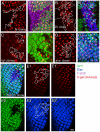The functions of auxilin and Rab11 in Drosophila suggest that the fundamental role of ligand endocytosis in notch signaling cells is not recycling
- PMID: 21448287
- PMCID: PMC3063240
- DOI: 10.1371/journal.pone.0018259
The functions of auxilin and Rab11 in Drosophila suggest that the fundamental role of ligand endocytosis in notch signaling cells is not recycling
Abstract
Notch signaling requires ligand internalization by the signal sending cells. Two endocytic proteins, epsin and auxilin, are essential for ligand internalization and signaling. Epsin promotes clathrin-coated vesicle formation, and auxilin uncoats clathrin from newly internalized vesicles. Two hypotheses have been advanced to explain the requirement for ligand endocytosis. One idea is that after ligand/receptor binding, ligand endocytosis leads to receptor activation by pulling on the receptor, which either exposes a cleavage site on the extracellular domain, or dissociates two receptor subunits. Alternatively, ligand internalization prior to receptor binding, followed by trafficking through an endosomal pathway and recycling to the plasma membrane may enable ligand activation. Activation could mean ligand modification or ligand transcytosis to a membrane environment conducive to signaling. A key piece of evidence supporting the recycling model is the requirement in signaling cells for Rab11, which encodes a GTPase critical for endosomal recycling. Here, we use Drosophila Rab11 and auxilin mutants to test the ligand recycling hypothesis. First, we find that Rab11 is dispensable for several Notch signaling events in the eye disc. Second, we find that Drosophila female germline cells, the one cell type known to signal without clathrin, also do not require auxilin to signal. Third, we find that much of the requirement for auxilin in Notch signaling was bypassed by overexpression of both clathrin heavy chain and epsin. Thus, the main role of auxilin in Notch signaling is not to produce uncoated ligand-containing vesicles, but to maintain the pool of free clathrin. Taken together, these results argue strongly that at least in some cell types, the primary function of Notch ligand endocytosis is not for ligand recycling.
Conflict of interest statement
Figures



References
-
- Scita G, Di Fiore PP. The endocytic matrix. Nature. 2010;463:464–473. - PubMed
-
- Le Borgne R, Bardin A, Schweisguth F. The roles of receptor and ligand endocytosis in regulating Notch signaling. Development. 2005;132:1751–1762. - PubMed
-
- Le Borgne R. Regulation of Notch signaling by endocytosis and endosomal sorting. Curr Opin Cell Biol. 2006;18:213–222. - PubMed
-
- Nichols JT, Miyamoto A, Weinmaster G. Notch signaling – constantly on the move. Traffic. 2007;8:959–969. - PubMed
Publication types
MeSH terms
Substances
Grants and funding
LinkOut - more resources
Full Text Sources
Molecular Biology Databases

